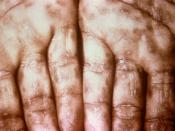There are now more than twenty disorders recognized as being transmitted primarily by sexual means. The more familiar STD's are AIDS, gonorhea, syphilis, chlamydia-related infections, genital herpes, candidiasis, nonspecific vaginitis, trichomoniasis, pediculosis, scabies, and urinary tract infections.
GONORRHEA
One of the most frequently encountered communicable diseases in the U.S.
It is caused by the bacterium Neisseria Gonorrihoeae, which is common all over the world
today and can only thrive in human beings. There is no way to acquire immunity to this disease. Anyone who is sexually active is susceptible to gonorrhea.
This disease is transmitted by the way of direct contact with the secretions of mucos membranes such as those of the urethra, cervix, vagina, anus, eyes and throat.
The contact involved in transmitting gonorrhea is almost always sexual in nature. It is possible that contaminated fingers can transfer infection from one region of the body to another, however, this is highly unlikely because the bacteria dies rapidly when
demed the warmth and moisture of mucous membranes.
Symtoms of infection usually appear within two to ten days after exposure but might take up to thirty days.
In males, gonorhea usually strikes first at the urethra, the tube that extends from the bladder to the tip of the penis. A burning sensation during urination may be experienced due to the irritation of the urethra's mucosal lining. Many males may also notice and abnormal discharge from the penis. The penis itself may be red or swollen at
the tip. Urination may become more frequent or difficult. Occasionally, no symptoms are evident immediately.
In females, gonorrhea seems to strike selectively at the cervix (the entrance of the uterus, but it also can appear elsewhere. As many as 80% of the females with gonorhea have no immediate signs or symptoms. One symptom in...


